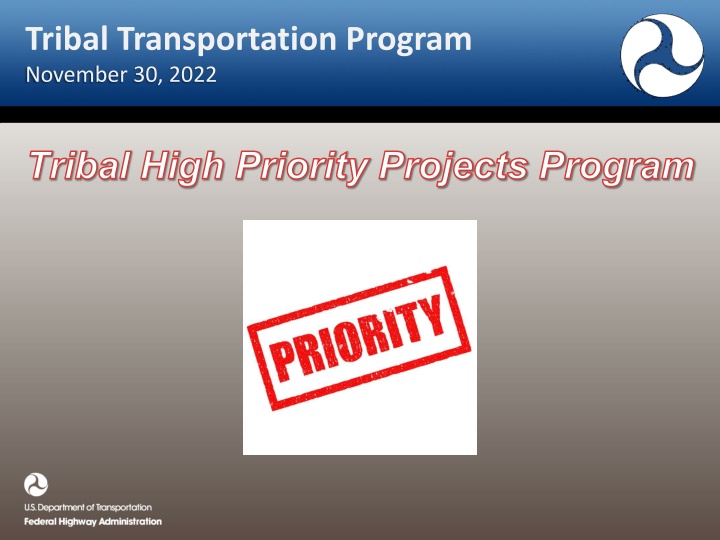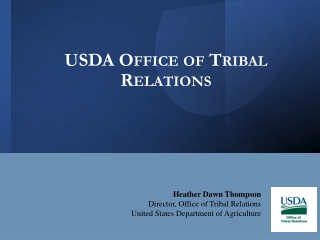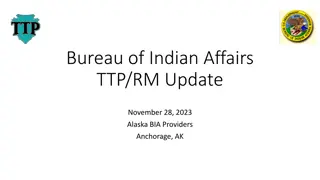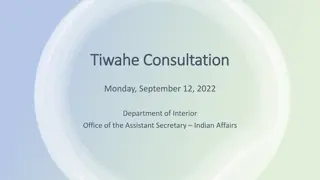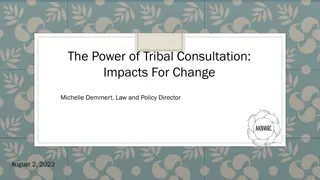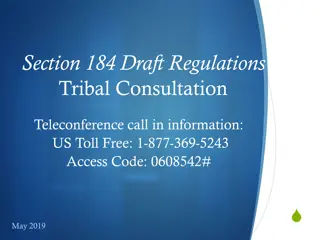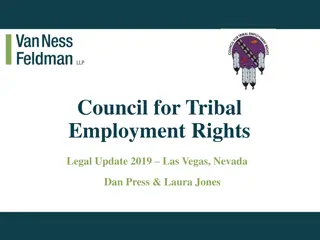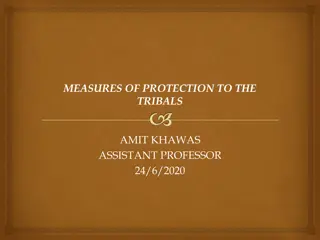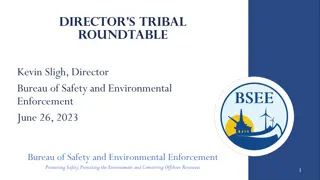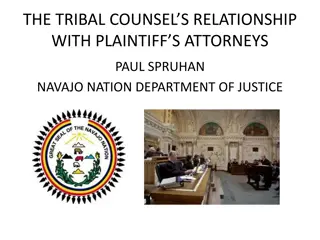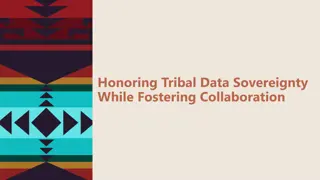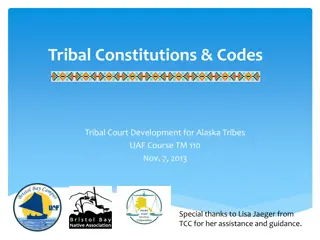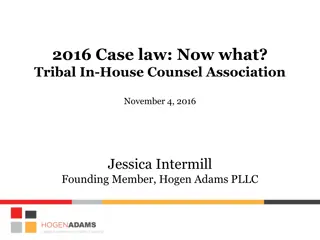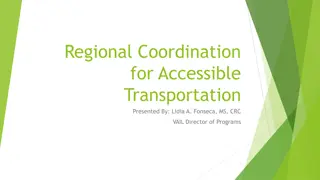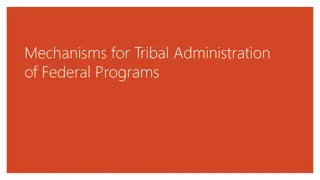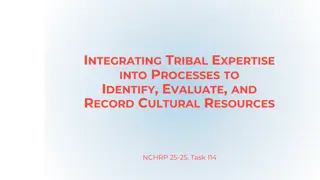Tribal Transportation Program Overview
Nationwide priority Tribal High Priority Projects Program providing funding for Indian Tribes' transportation projects with insufficient allocations under the Tribal Transportation Program. Learn about eligibility, application process, scoring, and fund administration.
Download Presentation

Please find below an Image/Link to download the presentation.
The content on the website is provided AS IS for your information and personal use only. It may not be sold, licensed, or shared on other websites without obtaining consent from the author.If you encounter any issues during the download, it is possible that the publisher has removed the file from their server.
You are allowed to download the files provided on this website for personal or commercial use, subject to the condition that they are used lawfully. All files are the property of their respective owners.
The content on the website is provided AS IS for your information and personal use only. It may not be sold, licensed, or shared on other websites without obtaining consent from the author.
E N D
Presentation Transcript
Tribal Transportation Program November 30, 2022 Tribal High Priority Projects Program
Contact Information Miles Brookes for Blane Kunihisa Tribal Coordinator and Tribal HPP Program Manager Blane.Kunihisa@dot.gov 360-619-7814
Learning Objectives After today, you will be able to: Explain what is the Tribal High Priority Projects Program Explain two ways to apply for Tribal HPP Program funding Explain how applications are scored and ranked Explain how program funds are administered Identify the resources available to applicants
What is the Tribal HPP Program? Purpose Nationwide priority program for: An Indian Tribe or governmental subdivision of an Indian Tribe whose annual allocation of funding under the Tribal Transportation Program is insufficient to complete the highest priority project of the Indian Tribe or governmental subdivision of an Indian Tribe; or Any Indian Tribe that has an emergency or disaster with respect to a transportation facility included on the national inventory of Tribal transportation facilities under section 202(b)(1) of Title 23, United States Code.
What is the Tribal HPP Program? Purpose Tribal HPP Program Emergency or Disaster Project Priority Project
History IRRHPP 25 CFR 170 (July 2004) Negotiated Rulemaking IRR set-aside 2005-2012 (SAFETEA-LU) $1M max request 28M+ awarded to 37 in 2012
History MAP-21 25 CFR 170 (July 2004 MAP-21 (2012) 23 U.S.C.. 202 Renamed to Tribal HPP Modeled after IRRHPP Program Funding Source Changed Not funded
History BIL 25 CFR 170 (July 2004 MAP-21 (2012) BIL (current) Points back to MAP-21 Amends funding source $9M set- aside $30M auth. to be appropriated from Gen. Fund
Priority Project Tribal HPP Program Emergency or Disaster Project Priority Project
Priority Project An Indian Tribe or governmental subdivision of an Indian Tribe whose annual allocation of funding under the Tribal Transportation Program is insufficient to complete the highest priority project of the Indian Tribe or governmental subdivision of an Indian Tribe
Priority Project Eligibility Applicant is an Indian Tribe or a governmental subdivision of an Indian Tribe Project cost is higher than Annual Allocation of TTP Funds (Tribal shares and 2% Planning) showing insufficient funds Project will become whole (fiscally constrained) with Tribal HPP Program funds, which is a requirement to be added on a FHWA- approved TTIP. Amount of funds requested is $1M or less Only 1 application for assistance pending at any one time (continued)
Priority Project Eligibility (continued) Funds can be used to carry out: Preliminary engineering Construction Construction Engineering o o o Funds cannot be used for: Transportation planning; Research; Routine maintenance activities; Work performed on projects not included on a TIP Purchase of equipment unless authorize by Federal law; Condemnation of land for recreational trails; and Other activities not involving transportation o o o o o o o
Priority Project How Are Applications Ranked Project Scoring Matrix Accident and fatality rate for candidate route project completed Tribal Bridge Program Design Need funds Geographic isolation All weather access for 6 different elements: (1) Employment; (2) Commerce; (3) Health; (4) Safety; (5) Educational Resources; (6) Housing Years since last IRR/TTP construction Readiness to Proceed to Construction or Percentage of Project matched by other Amount of Funds Requested Don t forget TTP Bridge Program
Priority Project Information To Provide Safety Severe at least one (1) fatality or suspected serious injury crash* within proposed project limits, occurred after the last safety improvement within project limits, and the project addresses a contributing factor of the crash. * As defined in NHTSA s Model Minimum Uniform Crash Criteria 5th edition
Priority Project Information To Provide Safety Moderate at least one (1) fatality or suspected serious injury crash* within proposed project limits, occurred after the last safety improvement within project limits, and the project addresses a contributing factor of the crash; OR proposed project has data/documentation to demonstrate the location(s) improvements are high risk either because of crash data on similar facilities or on the route(s) being improved by Implementing an effective safety countermeasure; OR Addressing a need identified in a current safety plan
Priority Project Information To Provide Safety Minimal at least one (1) property damage only crash* within proposed project limits, occurred after the last safety improvement within project limits, and the project addresses a contributing factor of the crash; OR the proposed project implements an effective safety countermeasure (FHWA Proven Safety Countermeasures, Modification Factors Clearinghouse, etc.)
Priority Project Information To Provide Safety No Accident Project does not meet one of the criteria above; OR No safety data/information provided on application
Priority Project Information To Provide Geographical Isolation No External Access Tribe or Village is globally isolated not accessible via roads Community Housing cluster of 3 or more publicly accessible single dwellings or residences Primary Access Functional classification of 1, 2, or 4 in NTTFI Secondary Access Functional classification of 3, 5-8 in NTTFI Substandard Construction need of 1, 2, or 4 in NTTFI (includes proposed roads) Tribal facility route and section in NTTFI
Priority Project How Do I Apply Submittals Submit the following to BIA or FHWA POC: Application form/document signed by Tribal Representative Attachments Cost estimate breakdown NTTFI data sheet showing route(s) and section(s) Official Tribal Action requesting the project AND providing authority of the Secretary of Interior to place the project on a TIP, if the project is selected and approved 1. 2. 3. (continued)
Priority Project How Do I Apply Submittals (continued) Submit the following to BIA or FHWA: Attachments (continued) Crash data or other supporting documentation Signed/stamped plan cover sheet, if applying for CN funds MOU of matching entity for any non-TTP matching funds Strip map identifying proximity to elements to verify all weather access 4. 5. 6. 7.
Emergency or Disaster Project Tribal HPP Program Emergency or Disaster Project Priority Project
Emergency or Disaster Project Any Indian Tribe that has an emergency or disaster with respect to a transportation facility included on the national inventory of Tribal transportation facilities under section 202(b)(1) of Title 23, United States Code.
Emergency or Disaster Project Eligibility Applicant is any Indian Tribe that has an emergency or disaster with respect to a facility included on the NTTFI under section 202(b)(1) of title 23, U.S.C. Only 1 application for assistance pending at any one time Cost of project is at least 10%of the Tribe s annual TTP funds (TTP Shares and 2% Planning) Funds requested is limited to estimated cost of repairing damage Cost of project is less than $700,000 (continued)
Emergency or Disaster Project Eligibility (continued) Funds can be used to carry out: Preliminary engineering Construction Construction Engineering o o o Funds cannot be used for: Transportation planning; Research; Routine maintenance activities; Work performed on projects not included on a TIP Purchase of equipment unless authorize by Federal law; Condemnation of land for recreational trails; and Other activities not involving transportation o o o o o o o (continued)
Emergency or Disaster Project Eligibility (continued) Damage to a Tribal transportation facility that: o Renders facility impassable or unusable o Is caused by A natural disaster over a widespread area; or A catastrophic failure from an external cause o Would be eligible under the ER program (23 U.S.C. 125) (continued)
Emergency or Disaster Project Eligibility (continued) Eligibility under 23 U.S.C. 125 requires: Emergency Declaration by the Governor of the state with concurrence by the Secretary of Transportation; or President of the U.S. has declared the emergency to be a major disaster for the purposes of the Robert T. Stafford Disaster Relief and Emergency Assistance Act (42 U.S.C. 5121 et seq.) for which concurrence from the Secretary of Transportation is not required. (continued)
Emergency or Disaster Project Eligibility (continued) Natural disaster An unusual natural occurrence such as a flood, hurricane, sever storm, tidal wave, earthquake, or landslide which causes serious damage. Serious damage Heavy, major, or unusual damage to an eligible facility which severely impairs the safety of usefulness of the facility or results in closure. (continued)
Emergency or Disaster Project Eligibility (continued) Wide area A tract sufficiently large to encompass parts or all of several entities such as counties, states, or federal agency management units (individual forests, parks, refuges, regions, districts, and so on) and can include areas outside of federal lands. Significant flooding would involve a number of major drainage basins. *Serious damage to roads caused by extraordinary storms occurring over small areas would not be considered eligible for ERFO funding. (continued)
Emergency or Disaster Project Eligibility (continued) Catastrophic failure The sudden failure of a major element or segment of the highway system due to an external cause. The failure must not be primarily attributable to gradual and progressive deterioration or lack of proper maintenance. The closure of a facility because of imminent danger is not in itself a sudden failure.
Emergency or Disaster Applications Priority Priority given to Emergency or Disaster Applications If submitted after FPL issued: o Funds provided on date on which unobligated funds are returned Highest Priority Projects bumped from FPL moves to top of list next Fiscal Year
How Do I Apply? Submittals for emergency or disaster Submit the following to BIA or FHWA POC: Application form/document signed by Tribal Representative Attachments Document demonstrating damage to a transportation facility Cost estimate breakdown NTTFI data sheet showing route(s) and section(s) Official Tribal Action requesting the project AND providing authority of the Secretary of Interior to place the project on a TIP, if the project is selected and approved 1. 2. 3. 4. Only 1 pending application at any one time, including emergency or disaster application.
Timeline Award Phase Evaluation Phase Soft Pre-Award Phase Applications submitted throughout the year and Funding Evaluation Application Cutoff for FY funding Award Kickoff Meeting Distribute Funds* Final FPL* Evaluation/Ranking* Outreach National Tribal Conference Annual Kickoff Webinar for Prospective Applicants (recorded) Typical Regional Workshop Season Typical Site Visit Season Send out Dear Tribal Leader Letter to all Tribes Program outreach to Tribes will occur throughout the year OCT NOV DEC JAN FEB MAR APR MAY JUN JUL AUG SEP * Date identified in the 25 CFR 170, July 2004
How are program funds administered? Tribal HPP Program funds shall be administered in the same manner as the TTP Funds made available for the Tribal HPP Program shall remain available until September 30 of the third fiscal year after the year appropriated Federal share of the cost of a project is 100%* *A project with a greater percentage of other sources of matching funds not provided under the Tribal Transportation Program will receive a higher score in accordance with the Project Scoring Matrix
What resources are available? Tribal HPP Program Website Eligibility and Application Checklist for the Tribe in assembling the application Application form Guide to fill out the application form Future Webinars My contact information
Tribal HPP Program Admin Team Blane Kunihisa, Tribal HPP Program Manager, FHWA OTT Miles Brookes, FHWA OTT, Alaska Region Andrew White, BIA Alaska Region Robert Frazier, BIADOT Demery Bill, BIA Pacific Region
Review Learning Objectives We discussed the following topics in this module: What is the Tribal High Priority Projects Program Two ways to apply for Tribal HPP Program funding How applications are scored and ranked How program funds are administered Resources available to applicants
